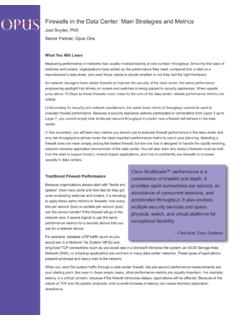Transcription of Market Guide for DNS, DHCP and IP Address …
1 Market Guide for DNS, DHCP and IP Address management 25 April 2014 ID:G00262756 Analyst(s): Andrew Lerner, Lawrence Orans VIEW SUMMARY Infrastructure and operations personnel can use DNS, DHCP and IP Address management solutions to improve network availability, reduce operational expenditure, and simplify and streamline administration of critical infrastructure. Overview Key Findings DDI consists of DNS, DHCP and IP Address management (IPAM) solutions that help organizations manage their IP addressing, DNS and DHCP services to improve overall availability and reduce operational expenditure, thus facilitating scalability to support business growth. There are several different types of vendors that provide DDI, ranging from large IT vendors (Microsoft, Cisco, Alcatel-Lucent and BT) to midsize DDI-centric vendors (Infoblox and BlueCat), as well as smaller and/or regionalized players (EfficientIP, Nixu Software and Men & Mice). When deploying a commercialized DDI solution, organizations with more than 5,000 employees and/or 25,000 IP addresses in use typically achieve substantial operational expenditure (opex) savings.
2 Organizations don't often switch vendors due to the criticality of DNS and operational expenditure associated with vendor migration; therefore, DDI solutions tend to be sticky. The DDI Market is relatively mature, and many DDI vendors provide functionality in adjacent markets, such as network security and network management . Recommendations If instability of DNS/DHCP services or inadequate IP Address management is leading to reduced availability in your environment, invest in DDI solutions. Deploy DDI solutions to improve availability and reduce opex when 25,000-plus active IP addresses are in use. Due to the stickiness of DDI products, use a five- to 10-year time horizon when planning investments in DDI. Vendors' deployment and migration approaches should be used as key evaluation criteria when making DDI investments. Include DDI as a prerequisite to any large IPv6 deployment or centralized Internet of Things (IoT) initiative.
3 Market Definition DDI solutions improve overall IT infrastructure availability while reducing operational expenditure. These solutions specifically Address the needs of server, network and other infrastructure and operations (I&O) personnel responsible for DNS, DHCP services and allocation of IP addresses within their organizations. I&O administrators use DDI products for the daily management of DNS and DHCP services, and to provide a structured workflow for basic network operations (for example, adding printers or servers, allocating IP ranges for new branches, etc.). Companies adopt DDI solutions when they are looking to step up from using rudimentary tools ( , spreadsheets) to manage IP addresses, and when they seek improved control and policies for managing network changes. Gartner estimates that usage of a commercial DDI solution can reduce opex by 50% or more, which can lead to savings of full-time equivalents (FTEs) in larger organizations (see Note 1).
4 As a result, Gartner has observed that a majority of organizations with more than 15,000 employees (or 50,000 IP addresses in use) use a commercial DDI ,4 DDI solutions are typically priced like a networking device, including a one-time initial hardware/software price and a yearly recurring maintenance fee. Price can vary significantly based on several factors, including deal size and volume ( , number of IP addresses managed), overall topology/architecture, vendor, and negotiated discount rate. Vendors' list pricing typically ranges from $1 to $3 per IP Address for the initial hardware/software purchase, plus an additional yearly maintenance fee in the range of 15% to 20% of the original hardware/software price. Return to Top Market Direction I&O organizations typically make investments in DDI to: Improve existing IP Address management capability and processes. Improve the stability of DNS and/or DHCP infrastructure, in order to increase overall availability for the applications and users that rely on this infrastructure.
5 Upgrade or replace a previous DDI solution that is coming to end of life. Delegate DNS and/or DHCP administration from senior to less experienced administrators. Help support and control a proliferating number of devices, including bring your own device (BYOD), attaching to corporate networks. Improve visibility and reporting for devices attached to the network. Gartner estimates there are approximately 10,000 to 15,000 commercial DDI solutions implemented globally and that 85%-plus of the 500 largest global enterprises utilize commercial DDI ,2,4. There is a moderate degree of Market fragmentation, as we estimate that no single vendor accounts for more than 45% of the worldwide DDI installed base, while four vendors account for roughly 4% to 12% In addition, deployed DDI solutions are often difficult to displace as: (1) they are sticky, due to DNS criticality; and (2) organizations often wrap organizational process and technology around them ( , integration into ticketing systems and workflows).
6 As a result, the planning and costs associated with migrating existing DNS/DHCP services are extremely important to consider when a new DDI solution is being proposed. In the small or midsize business (SMB) Market , the need for DDI is dramatically reduced due to the lack of scale in IP services. In addition, Microsoft's DDI solution (which is provided at no additional cost with Windows Server 2012 R2) satisfies many SMB DDI needs. Return to Top Additional DDI Drivers There are several additional drivers impacting the DDI Market , including automation, DNS Security Extensions (DNSSEC), IoT, IPv6, software-defined networking (SDN) and adjacent network services. Return to Top Advanced Automation to Enable Private Cloud Several DDI vendors have integrated their solutions with leading hypervisor and cloud management platforms (CMPs) in the hopes of getting "baked into" private cloud initiatives. These integrations are aimed at automating the DDI processes (for example, changes to DNS zone files) that result from spinning up and spinning down virtual servers.
7 Only the most advanced private cloud environments have implemented this level of automation. Gartner estimates less than a 5% adoption rate for these advanced automation features among DDI customers. Bottom Line: Most enterprises are not quite ready to take advantage of the automation capabilities provided by DDI solutions, because their private cloud implementations don't require automating changes to DNS services. However, where these changes are required, DDI integration with the virtualization infrastructure ( , hypervisors, CMPs, etc.) is a valuable capability that can further automate private cloud implementations. Return to Top DNSSEC In recent years, the and other governments have mandated the adoption of DNSSEC, which is aimed at preventing DNS cache poisoning attacks. Despite these mandates, DNSSEC has a low adoption rate. Statistics from Google indicate a low volume of DNSSEC transactions (only 7% of client-side queries are DNSSEC-enabled, and about 1% of server-side responses are signed).
8 5 Bottom Line: All the vendors in this research have added features to help enterprises implement DNSSEC. However, due to its low adoption rate, DNSSEC has not been a driver for DDI adoption. Return to Top Internet of Things Gartner estimates that the IoT will result in over 26 billion units by 2020. IoT initiatives require a massive number of devices (often millions), and centrally managing IP services at this degree of scale requires robust DDI solutions. The IoT drives increased interest in and additional need for commercial DDI solutions (see "The Impact of the Internet of Things on Data Centers"). However, many initial IoT initiatives will be deployed in a decentralized fashion, leveraging IP services from the local networks where devices reside which reduces the need for robust DDI. Bottom Line: Clients undertaking IoT initiatives that require centralized IP services will require DDI, and Gartner anticipates moderate growth in the DDI Market as a result of IoT during the next 18 months.
9 Return to Top IPv6 Worldwide adoption of IPv6 is limited and, by most estimations, global Internet IPv6 traffic is around or under 3% (but has doubled in the past six to 12 months; based on the percentage of users who access Google via IPv6). Organizations that are undertaking large IPv6 initiatives will likely require DDI due to: Difficulty in notating IPv6 addresses versus IPv4 The massive number of IP addresses associated with any v6 implementation (best practices dictate that each network segment is assigned over 65,000-plus usable IP addresses) However, most organizations plan to limit initial IPv6 deployments to public-facing Internet networks This incremental approach limits the additional requirements for DDI in most organizations. Bottom Line: All the vendors in this research have added IPv6 functionality, and DDI solutions simplify IPv6 rollouts. However, Gartner anticipates limited overall DDI Market growth due to IPv6 adoption during the next 12 months (see "Create the Right IPv6 Road Map for Your Organization").
10 Return to Top SDN Gartner defines SDN as a new approach to designing, building and operating networks that brings a similar degree of agility to networks as abstraction, virtualization and orchestration brought to server infrastructure (see "Ending the Confusion About Software-Defined Networking: A Taxonomy"). SDN provides a potentially new way to deliver peripheral network services including DDI. However, to date, DDI vendors are not delivering their commercial DDI software via SDN architectures. In addition, while there has been a large degree of hype around the technology, there has been extremely limited mainstream adoption of SDN thus far. As of January 2014, Gartner estimated that there are less than 500 production implementations worldwide (see "Mainstream Organizations Should Prepare for SDN Now"). Bottom Line: Gartner anticipates that SDN will lead to new deployment approaches for DDI, but will not drive increased DDI adoption during the next 18 months.







